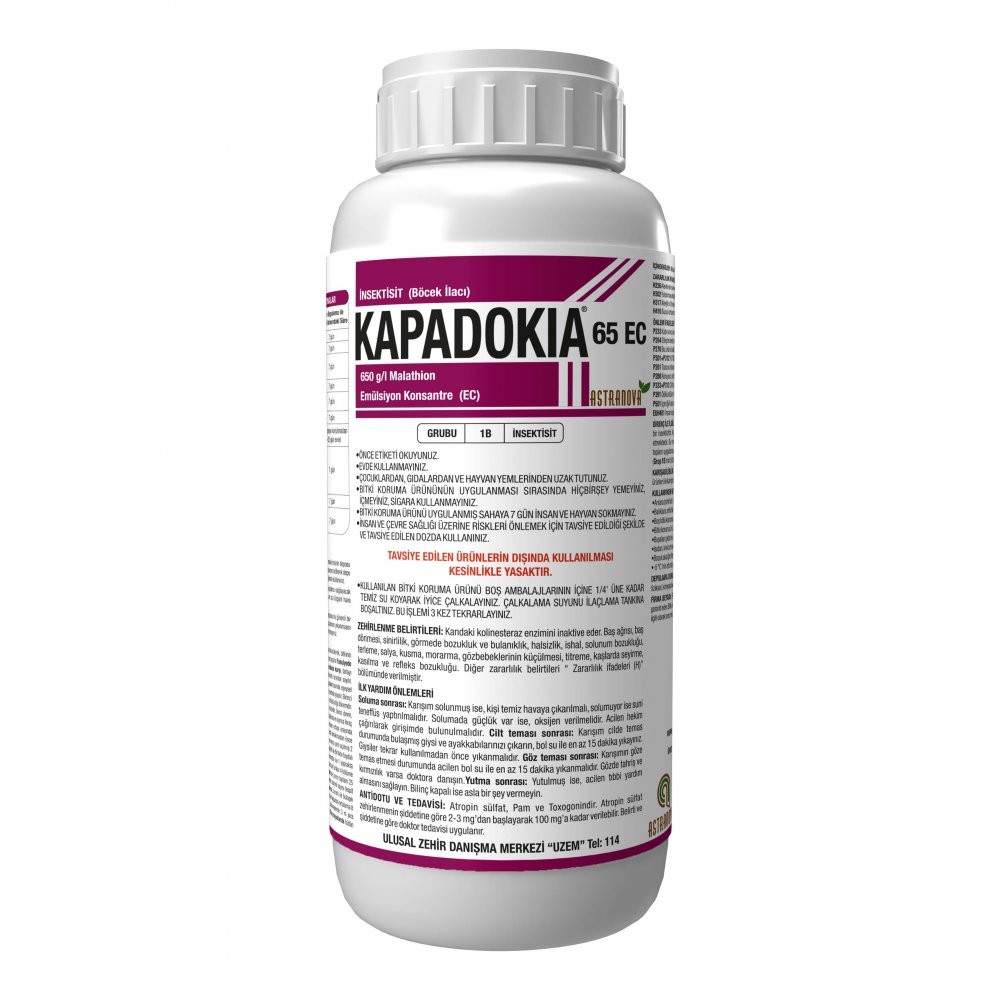KAPADOKIA 65 EC

Active Incradient: 650 g/l Malathion
Formulation: Emulsion Concentrate (EC)
Packing: 250 ml, 500 ml, 1 L, 5 L, 10 L
Use plant protection products with care.
Be sure to read the label and product information before use.
Label Information Safety Data Sheet Product Brochure|
Plant name |
Name of harmful organism |
Application dose and period |
Time between final application and harvest |
|
tomato |
Greenkurt (Helicoverpa armigera) |
200 ml/da larvae |
7 days |
|
bean |
Bean capsules (Etiella zinckenella) |
200 ml/da larvae |
7 days |
|
Egypt |
Cotton striped leafy (Spodoptera exiqua) |
200 ml/da larvae |
7 days |
|
Corn warehouse pests |
200 ml/100 m2 area |
||
|
apricot |
Peach moth (Anarsia lineatella) |
150 ml/100 l water larva |
7 days |
|
The vineyard* |
Unlubit (Planococcus citri) |
150 ml/100 l water In all periods |
7 days |
|
hashish |
Poppy fir (Ceuthorrhynchus denticulatus) |
200 ml/100 l water adult |
7 days |
|
Grain |
Warehoused cereals and products against pests |
Empty storage application to 200 ml/100 m2 area |
Before the product is put in storage 20-25 days ago |
|
cotton |
Cotton striped leafy (Spodoptera exiqua) |
250 ml/da larvae |
7 days |
|
Cotton leafbite (Aphis gossypii) |
100 ml/da, adult-nymph |
||
|
Leafpires (Empoasca decipiens, Asymetrosca decedens) |
170 ml/da, adult-nymph |
||
|
sesame |
Sesame moth (Antigastra catalaunalis) |
100 ml/da larvae |
7 days |
|
soy |
Piskokulu green bug (Nezara viridula) |
170 ml/da nymph-adult |
7 days |
|
Cotton striped leafy (Spodoptera exiqua) |
250 ml/da larvae |
(*) It is not used in vineyard areas where vineyard leaf will be harvested for consumption purposes.
HOW TO USE THE PLANT PROTECTION PRODUCT In tomato, by entering the field diagonally against green leaves, 50-100 plants are checked according to the size of the field, and eggs and larvae are searched in the flowers, leaves, stems, fruits and shoots of the plant. If 5 out of 100 plants are found, the application is made. It is applied as green parts spraying against bean capsule weed in beans. Against the cotton striped leafworm in corn, a total of 25 plants, 5 plants side by side at 5 points on the row, representing the field, are checked and the larvae are counted. The application is done when there are 2 larvae / plant on average. Apricot Against peach moth, sexual attractive traps, effective temperatures and plant phenology are used in determining the application time.
Against Unlubite in the vineyard, the struggle is done in two periods. The first period is the period when wetness begins to be seen in the shells on the body of the vine and the mealybug starts to move towards the green part. In this period, the vines are about the size of chickpeas and should be applied to the vines where only mealybug is seen. The second stage is the period in which mealybug passes into leaves and clusters and the grains begin to taste. If contamination is detected in most of the grapevines and also in the exported varieties, application can be made in both periods. Against the Poppy rootworm in poppy, when the emergence of adults from the soil reaches the highest density between March and mid-April and when at least 10 adults are seen per m2, application is made before laying eggs. Against cotton striped leafworm in cotton, application is made when 10 larvae or 2 newly opened egg packs are seen in 100 plants during the controls. In field controls against cotton aphids in cotton, spraying should be delayed if beneficial insects and aphids are intense. Fighting is recommended when an average of 25 aphids are detected in 1 leaf during the seedling period and 50% infected seedling after dilution. The cotton field of 50 da is divided into 4 sections in surveys against cotton leaf fleas. Leaf fleas on all 25 leaves, 1 each taken from the lower, middle and upper parts of the main body of the plants randomly selected from each section, are counted. In this way, the average number of pests per leaf in a total of 100 leaves in the whole area is determined. Application should be made when an average of 10 leafhoppers are detected per leaf. Chemical control is applied against sesame moth when the rate of plants contaminated with the pest is 20%. Chemical control is applied when an average of 8 adults + nymphs with a row length of 3 meters are detected in soybean against foul-smelling green beetle. Soybean Cotton striped leafworm should be applied when there are 6 larvae of 3 m row length in the surveys or when there are 2 newly opened egg packs. In empty tanks, it is applied in a way to wet all surfaces.
MIXABILITY: Dinitro compounds should not be mixed with Metalaxyl and alkali protection products. A pre-mix test and phytotoxicity test are recommended before mixing with other plant protection products.